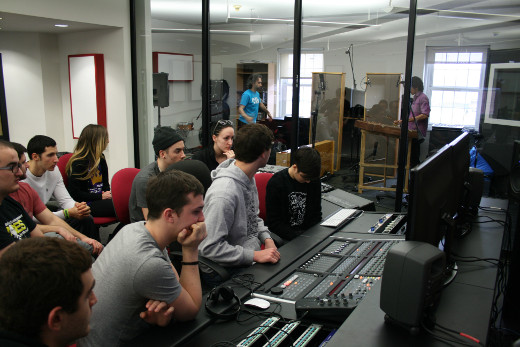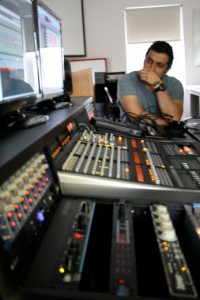Sonic Science: Studio Meets Laboratory at Stevens Institute of Technology
Rob Harari is facing a very different kind of student body.
Standing in front of the newly minted music studio at the Stevens Institute of Technology – College of Arts and Letters (CAL) in Hoboken, Harari – the Technical Director of the CAL Music & Technology Program and an Associate Professor there – has an unusually diversified group of pupils to instruct. And these undergrads mark a distinct changing of the guard in audio.
“These freshmen were the first generation born with an iPod in their crib,” Harari says. “For the educators, there’s an intuitiveness to the technology that we haven’t seen before. That means there’s a lot of people who know how things work in the box, but can’t necessarily translate it in the analog domain – the ‘real’ world.
“That’s why it’s so important to make them think. Because if you can’t make the jump, you’ll only go as far as the box lets you.”
An Academic Backdrop
For Harari, the opportunity to guide his charges out of that trap came with the green light to build a new 3,400 sq. ft. music studio within Stevens’ CAL complex.
Part of a 55-acre campus that overlooks the Hudson River with expansive views of Manhattan, the CAL Music Studio was designed specifically with Stevens’ remarkably diversified approach firmly in mind. Founded in 1870, the higher-learning institution today consists of three schools and one college: the Wesley J. Howe School of Technology Management (STM), the Charles V. Schaefer Jr. School of Engineering and Sciences (SES), the School of Systems and Enterprises (SSE) and CAL.
Whether at the undergraduate, graduate or PhD level, the watchwords at Stevens are “multidisciplinary” and “interdisciplinary”. As a result, the Stevens student is immersed in an academic world of which audio is only one part – courses dealing with electricity and magnetism, circuits and systems, thermodynamics, modern physics, technogenesis, and more form their daily core.
“This facility is meant to support the production classes in the music and technology program, as well as provide a research facility for students who want to explore things like soundwave propogation and transducer technology,” Harari says. “So, for example, if there are students in SES who are making an iPhone app with an application for the music industry, they can work the bugs out here.”
Lesson Plan: Audio Quality & Signal Flow
Harari, who had been served as an adjunct professor at Stevens for several years before taking on the full time Technical Director role in 2008, began the buildout of the CAL Music Studio in earnest this January, after Stevens approved the plan to transform a former computer lab into an advanced audio instruction facility.
An expansive, sun-filled space with plenty of windows, the studio has room for up to 24 students. At the front, an SSL Matrix console is at the heart of the activity, complemented by a Yamaha 96v console in a separate learning station to the right. Both boards are linked to Mac towers running Pro Tools HD. On the left, a large live room complete with piano, drums, amps, and space for myriad instruments is separated from the classroom/control space by floor-to-ceiling glass walls, accessible by a sliding door.
Working closely with Shane Koss of Alto Music NYC, and after reaching consensus with the entire Music & Technology faculty, Harari procured a select equipment list that supported his exacting curriculum while staying on budget.
A customized Argosy stand holds the new SSL Matrix, along with outboard such as an Empirical Labs Distressor, Chameleon Labs 7802 Stereo Opto Compressor, Focusrite Isa828 8-channel mic pre, and MOTU Midi Express XT USB MIDI interface. A Universal Audio UAD2 Quad card is also part of the package. Meanwhile, monitoring comes via Dynaudio BM15A speakers and a Genelec 8020 5.1 surround system, delivering signal garnered from mics by Neumann, Sennheiser, Beyerdynamic, Shure, and AKG.
While a commercial studio’s hardware/software list will reflect the needs and aesthetic sensibilities of the owner and their expected client base, the equipment manifest of an educational studio necessarily has a different spin.
In Stevens’ case, it springs directly from Harari’s audio education approach, developed from his many years of live audio engineering and mixing records for Gregory Hines, Spyro Gyra, Dion Parsons, Savion Glover for Spike Lee and Barbra Streisand, Boys Night Out, Jazzheads Records, David Broza and Swingadelic.
“One school of thought is that if the technology you invest in for a facility has the functions that you need to teach, then you’ve covered your responsibility,” says Harari. “What’s missing in that statement is the quality of sound. The quality of sound is what I have to teach, because if a student doesn’t understand that from the start, they’ll never be able to go out and achieve it later on in a professional recording studio, post production, or broadcast situation.
“We have great plugins,” Harari continues, “but I teach theory about dynamic response and compression, for example, so when they’re listening for the difference between a tube compressor and a plugin, they know what’s going on. If they don’t have the understanding of the analog domain, they won’t conceptually understand what the algorithm is doing.”
The clear articulation of signal flow is Harari’s other top mission, a priority that’s once again illustrated in the gear choices.
“If students just learn how it works in the software, then show up at a live sound gig and have to troubleshoot, they may find themselves in a tough situation,” Alto’s Shane Koss points out. “People who are building a home studio may not necessarily invest in the Matrix or the Focusrite mic pres. But if you have to demonstrate everything that you can’t see going inside of Pro Tools, then the Matrix is great because you have so many routing options. That’s a good thing to understand.”
Linked In Learning
Although the CAL Music Studio can accommodate up to 24 people in its seating section, Harari is careful to cap classes at 16 students. Meanwhile, Koss designed and installed a networking system for the facility to ensure that everyone involved is getting maximum learning time.
Large flat-screen monitors displaying the open Pro Tools session are mounted high overhead both the SSL and Yamaha consoles, as well as in the live room. “The two main computer stations are connected via control and audio, so we have feeds going back forth through the space,” explains Harari. “For example, when we’re doing ADR work, both the students and the artists can see what’s going on in the Pro Tools session. That’s a big deal in the recording studio – no one likes being the artist behind the glass, seeing people having a conversation and not knowing what they’re saying.”
As befits Stevens’ multi-disciplinary makeup, Harari is looking forward to the CAL Music Studio hooking on to the school’s network as soon as possible. “We’d like to plug into Stevens’ fiber optic network, so we can start recording performances from our live theater, for example, as well as supporting media production across the campus,” he says. “More importantly, we’re getting to the point where our music technology program becomes a true research facility. There’s a sound synthesis research center here at Stevens – clearly, we’ll be able to do some big team projects when we’re all connected.”
Engineering Audio
Looking around, the convergence of audio education with other academic programs is on the rise. The recent $70 million gift that Dr. Dre and Interscope chairman Jimmy Iovine made to the University of Southern California confirms that, with their mandate of creating a cross-disciplinary academy where music production, entrepreneurship and computer science combine.
The USC developments should hatch some welcome advancements of their own. Meanwhile, Stevens’ lower-profile program is already blinding ‘em with science.
“Right now, approximately 15% of our music technology majors are earning double degrees, in programs like computer science, civil engineering, and physics,” says Harari. “Last year, one student’s project was to make a laser pickup for the guitar. Think about that: You can translate that output into any signal – binary code, MIDI – and it’s hugely accurate. That’s from a student that’s 19 years old.
“Another thing that just happened here is the Alternative Controller Ensemble (A.C.E). One of our students built a laser theremin, that he then wrote code for that would translate to MIDI. Another student has created a different type of control surface that he wants to patent and hopes to market. Part of my mission – and my fortune — is to work with smart people who want to figure out the relationship between music and research.”
At the heart of the new Stevens facility is a mindset that doesn’t just enable students to be proficient in using the analog and digital tools of today’s recording, post, and broadcast facilities. They’re also invited to invent the next generation of audio solutions.
“We want our students to be able to explore different ways to do things than the way people are doing them now,” Rob Harari observes. “My goal is for our students to innovate new products, come up with a way to do things better, create plugins no one else has thought of, or make a brain-controlled interface. It’s not the same output – that’s for sure.”
— David Weiss
Please note: When you buy products through links on this page, we may earn an affiliate commission.









